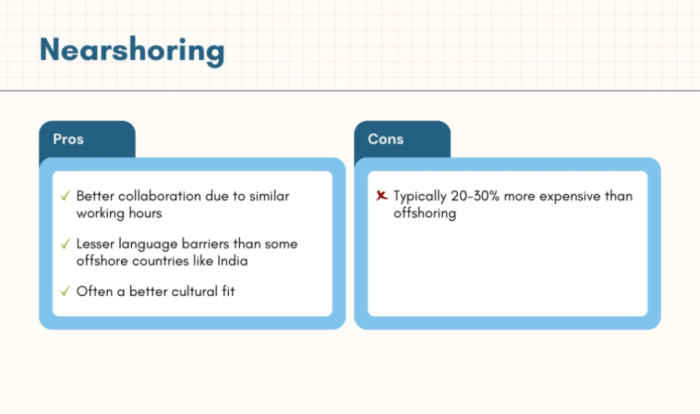In today’s globalized economy, businesses are constantly seeking ways to optimize their operations and enhance their competitive edge. One increasingly popular strategy is onshoring, the practice of relocating business processes or production back to the company’s home country. This guide delves into the specifics of onshoring software services, exploring its benefits, challenges, and considerations for businesses contemplating this strategic shift.
Onshoring your software services offers benefits like enhanced control and direct communication. However, if you need a cost-effective solution with reduced time zones differences, exploring a nearshore software development partner. might be beneficial. Ultimately, the best choice for your company depends on your specific needs and priorities, whether it’s the direct approach of onshoring or the strategic advantages of nearshore solutions.
Understanding Onshoring Software Development
Onshoring software development involves bringing software development, maintenance, and support operations back to the company’s domestic market. This contrasts with offshoring, where these tasks are outsourced to a foreign country, and nearshoring, where they are outsourced to a nearby country. The decision to onshore often stems from a reevaluation of cost-effectiveness, quality control, communication efficiency, and the need for closer collaboration with development teams.
Benefits of Onshoring Software Services
- Improved Communication and Collaboration: Onshoring significantly reduces communication barriers and time zone differences. This leads to smoother collaboration, faster problem-solving, and improved project management.
- Enhanced Quality Control: Direct oversight and proximity allow for more rigorous quality control measures. This results in higher-quality software products and fewer defects.
- Stronger Intellectual Property Protection: Keeping development in-house strengthens intellectual property protection and reduces the risk of security breaches or data leaks associated with outsourcing.
- Increased Security and Compliance: Onshoring facilitates better adherence to data privacy regulations and industry compliance standards, particularly important for businesses handling sensitive information.
- Boost to Domestic Economy: Onshoring contributes to job creation and economic growth within the company’s home country.
- Improved Employee Morale and Retention: For companies that value employee well-being, onshoring can lead to improved employee morale and retention rates.
Challenges of Onshoring Software Services
- Higher Labor Costs: A significant challenge is the potentially higher labor costs compared to offshoring destinations. Careful budgeting and resource allocation are crucial.
- Talent Acquisition Difficulties: Finding and retaining skilled software developers in a competitive domestic market can be challenging. Competitive salaries and benefits packages are essential.
- Increased Infrastructure Costs: Setting up and maintaining the necessary infrastructure for an in-house software development team can be expensive.
- Potential for Bureaucracy: Navigating domestic regulations and compliance requirements can be more complex than dealing with foreign jurisdictions.
Factors to Consider Before Onshoring
Before embarking on an onshoring initiative, businesses should carefully consider several key factors:
Cost-Benefit Analysis:
A thorough cost-benefit analysis is essential. Compare the costs of onshoring (labor, infrastructure, compliance) with the potential benefits (improved quality, communication, security). Consider long-term implications and potential ROI.
Talent Acquisition Strategy:
Develop a robust talent acquisition strategy. This includes identifying the required skill sets, creating competitive job descriptions, and implementing effective recruitment processes. Consider partnerships with universities or coding bootcamps.

Infrastructure Requirements:
Assess the necessary infrastructure, including office space, hardware, software, and network security. Evaluate the costs associated with setting up and maintaining this infrastructure.
Legal and Regulatory Compliance:
Ensure full compliance with all relevant domestic laws and regulations, including labor laws, data privacy regulations, and industry-specific compliance standards.
Project Management Methodology:
Choose a suitable project management methodology (Agile, Waterfall, etc.) to ensure efficient project execution and collaboration within the in-house team.
Case Studies of Successful Onshoring
(Note: Specific case studies would require further research and access to company information. However, many large companies have successfully onshored aspects of their software development, often highlighting improved quality and communication as key drivers.)
Frequently Asked Questions (FAQ)
- Q: Is onshoring always more expensive than offshoring? A: Not necessarily. While labor costs might be higher, the gains in efficiency, quality, and reduced risk can offset the increased expenses in the long run. A thorough cost-benefit analysis is crucial.
- Q: How can I find skilled software developers for onshoring? A: Utilize various recruitment channels, including online job boards, professional networking sites (LinkedIn), university partnerships, and recruitment agencies specializing in tech talent.
- Q: What are the key security considerations for onshoring? A: Implement robust cybersecurity measures, including secure networks, access controls, data encryption, and regular security audits. Consider compliance with relevant data privacy regulations.
- Q: What are the benefits of onshoring for employee morale? A: Onshoring can foster a stronger sense of community and belonging among employees, leading to increased job satisfaction, reduced turnover, and improved collaboration.
- Q: How can I measure the success of my onshoring initiative? A: Track key metrics such as project completion rates, software quality, customer satisfaction, and employee retention. Regularly review and adjust your strategy based on performance data.
Conclusion
Onshoring software services presents a compelling alternative to offshoring for businesses prioritizing quality, security, and collaboration. While higher initial costs might be a concern, the long-term benefits – improved communication, enhanced quality control, stronger IP protection, and increased efficiency – can significantly outweigh these expenses. By carefully considering the factors discussed above and implementing a well-defined strategy, businesses can successfully onshore their software development operations and gain a competitive advantage.
References
(Note: This section would include links to relevant articles, reports, and studies on onshoring, software development, and related topics from reputable sources such as Gartner, Forrester, McKinsey, etc. These would need to be researched and added.)

Call to Action
Ready to explore the possibilities of onshoring your software development? Contact us today for a free consultation to discuss your specific needs and how we can help you navigate this strategic transition.
